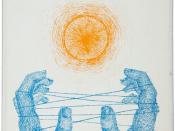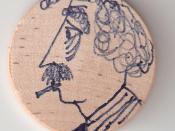In CatÃÂs Cradle by Kurt Vonnegut, religion is juxtaposed with the concept of a catÃÂs cradle. Vonnegut uses Bokononism, the bookÃÂs main religious theme, to coalesce the idea of a catÃÂs cradle. Bokononist ideals are similar to a catÃÂs cradle in several ways, including emptiness or holes, a need for a secondary person and its extra string or unnecessary amounts of string. This is shown in several aspects of Bokononism such as rituals, the concept of foma as a basis for religion and creationist stories and other myths a Bokononist holds dear.
In a catÃÂs cradle there are often empty spaces or holes that tend to mean nothing to the actual end product. These are similar to the use of foma as BokononismÃÂs core ideology, and how many of Bokononists know of these untruths and still follow the religion. In the very prologue of the book, it is stated, ÃÂNothing in this book is trueÃÂ Live by the foma that make you brave and kind and healthy and happy.ÃÂ
Meaning that the very religion itself is a lie, its core belief is to make people happy through lies and to give them hope through endless heresy. The fact that many bokononists on San Lorenzo are being prosecuted for their religion makes them even more complacent to practice in secret. And yet President Monzano himself states that, ÃÂ[he is] a member of the Bokononist faith.ÃÂ (218) and this endless persecution of his people is only meant to increase their faith and make them believe that bokononism is the way. The fourteenth book of Bokonon summarizes most of bokononism into one final argument. The book, entitled ÃÂWhat can a thoughtful man hope for mankind, given the experience of the past million years?ÃÂ (245) is all put into one word, ÃÂnothing.ÃÂ (245) This emptiness in faith and meaningless persecution scar the bokononist religion with holes throughout its core manifest.
Secondary persons are often needed to complete a catÃÂs cradle; the entire process is very intricate and is much more wholesome with another hand. This is true for many Bokononist rituals such as boko-maru and the idea of a duprass and karass. Boko-maru is a very mind numbingly beguiling at the core. It is very resembling of a sexual nature from a third person perspective yet it is a commonplace ritual between two or more bokononists to mingle their souls. Yet according to Jonah this simple ritual made him confess that he, ÃÂ[had] known [Mona] for a thousand years.ÃÂ (206) This mingling between two people was very complacent and simple yet it led to a very complex and innate relation afterwards between Mona and Jonah. A duprass as stated in bokononism is, ÃÂa karass composed of only two persons.ÃÂ (86) It is a very one sighted relationship between two people to which according to Bokonon, ÃÂcanÃÂt be invaded, not even by children born of such a union.ÃÂ (86) This strong intermingling of two persons is very sacred at heart but yet very couple oriented and much of the love is only between each other. A karass in bokononism is, ÃÂhumanity organized into teams, teams that do GodÃÂs will without ever discovering what they are doing.ÃÂ (2) This is a very broad group of people yet in bokononism is a very sacred unit, much like a catÃÂs cradle design, each member of the karass helps or understands each other and often meshes well. BokononÃÂs calypso states a karass is, ÃÂso many different people in the same device.ÃÂ (3) This is also true for a catÃÂs cradle, for it has many threads of string into a same design.
The final form of the catÃÂs cradle is a conundrum; it is almost irreverent of any cat or cradle in particular. Bokononism has a similar fate that pertains to its creationist stories of Borasisi and Pabu and the story of manÃÂs purpose. The story of man from mud is a very unique and almost unimportant tale. When God created man from mud, man stood and looked around him, seeing everything useless. Man asks God, ÃÂwhat is the purpose of all this?ÃÂ (265) And God replies, ÃÂeverything must have a purposeÃÂ then I leave it to you to think of one for all this.ÃÂ (265) With that thought God left Man to think of purpose itself. This resembles a catÃÂs cradle in the fact that when one sees through it or at it, it neither resembles its original purpose or idea, nor fulfills it. It is its very own purposeful puzzle, and man is here to figure it out. Borasisi and Pabu, the Sun and Moon is another common cosmology tale important to Bokononists. Borasisi, ÃÂheld Pabu, the moon, in his arms, and hoped that Pabu would bear him a fiery child.ÃÂ (190) And Pabu, bearing nothing but planets had her children scattered at BorasisiÃÂs will. Pabu stayed with her favorite child, Earth. This tale is a very useless cosmogony and it bears nothing towards Bokononist teachings, it is merely an extra tangle in the final design of a catÃÂs cradle.
The catÃÂs cradle is truly a masterpiece of human thinking and thought; itÃÂs very intricate and complicated, yet wholesome and unrelenting in thought. The many aspects that it contains are unique and placid in nature, and yet to this day it is a widely done technique. Its true purpose or form has not been surmised yet it has correlation with many religious theologies that people use today. Religion is humanityÃÂs own catÃÂs cradle.





